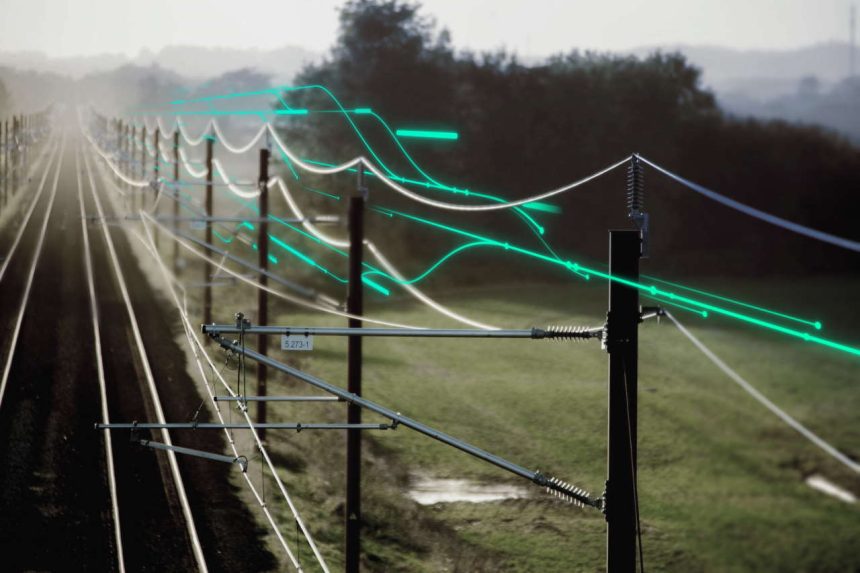Siemens Mobility has entered a partnership with the University of York and British Solar Renewables to develop revolutionary solutions for powering Britain's railways.
The projects are intended to demonstrate Net Zero Traction on the East Coast Main Line and a 25kv battery train charging station, and two separate funding streams have been made available.
The first project will allow the company to complete the final stages of technical development of a solution that allows solar energy to be fed directly to trains. Funds for this development have been provided by the Department for Transport through Innovate UK's ‘First of A Kind' programme. The study aims to overcome the engineering problems that have so far prevented renewable power to be used for supplying 25kV trains and supports plans to demonstrate the use of solar energy to power trains on the East Coast Mainline later this year.
The second development is exploring the feasibility of introducing a charging station that can charge on-train batteries in areas not yet electrified so that green routes can be created in which trains are powered by batteries or electricity anywhere on the network. If the development is successful, diesel trains on non-electrified lines can be phased out and replaced by electric, to provide faster, quieter journeys, no local air pollution, and a large reduction in carbon emissions.
Both projects are due to be completed by the end of December 2023. Data from the projects will be used in the next phase in which Siemens Mobility and its partners roll out demonstration projects.
ECML Net Zero Traction Decarbonisation Demonstration
This project will work with British Solar Renewables, the University of York, Network Rail, DB Schenker, and East Coast Mainline operators to research, develop, and come up with a pilot for the installation and testing of a prototype converter on the East Coast Mainline.
25kV Battery Train Charging Station Demonstration
Working with the University of York, Network Rail, West Coast Mainline operators, and Angel Trains, this project will develop and install a solution that will enable charging from existing standard local power supply cables, and is compatible with all trains that are powered from overhead lines. It is hoped that the small, low-cost design will allow diesel passenger trains to be replaced by electric on routes that are not continuously electrified.
Rob Morris, Managing Director, Rail Infrastructure for Siemens Mobility said: “Transportation in Britain accounts for 27% of carbon emissions and electrification of the country's rail network is vital to transform the everyday journeys for passengers and accelerate the journey to net zero.
“Our findings could revolutionise how electricity powers UK railways, opening up the possibility of a large-scale shift to green electricity across the whole country, reducing costs and creating a raft of new job opportunities at the same time.”
Piran White, Professor of Environmental Management from the University of York said: “We're excited to be supporting the decarbonisation of Britain's railways. We bring a strong evidence-based approach to support engineering and design to optimise for railway demand, maximisation of solar efficiency, biodiversity gain and test the potential for combined agricultural use in a world-leading collaboration.”

No chance way too much power needed, you would have to cover usable fields – battery power is just a stop gap to hydrogen, more studies investment should be going into hydrogen, battery power isn’t really green.
My previous comment on this story, made 24 hrs ago, appears not to have been approved. Could this be because I questioned solar power directly powering East Coast mainline trains and that this sort of question about “green” intitiatives is now not permitted?
Hi Chris,
Comments can take 24-48 hours to appear if they have to be manually approved,
maybe they should now disciurage carparking at stations and encourage cycling walking and [electric]bus services to connect with trains too
Hmm…I can understand using solar energy to charge batteries either on trains or at the lineside. But this report also talks about solar power directly powering East Coast main line trains. Presumably the East Coast main line would need to be surrounded along its entire length with solar panels to have any hope of generating enough electricity to keep all the trains on the line running. But what happens when the sun goes behind heavy clouds (as it often does in the UK) or it’s nightime (which is pretty long in our winters)? Will all the trains just stop until the sun re-appears?